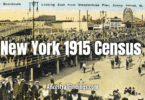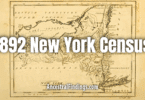The 1880 US census is an important genealogical tool for a number of reasons. The primary one is that it is the first US census to ask detailed questions about the individuals enumerated in each household. Previous censuses only asked for basic information, and the 1880 US census goes far beyond this, revealing some interesting and highly useful genealogical gems.
Secondly, it is the last US census available for another twenty years, thanks to the destruction of most of the 1890 census. Because a large part of that census was destroyed in a fire in 1921, and the rest was disposed of by the government more than a decade later, records for only 6,160 individuals in the United States still exist for the 1890 census. Family history researchers who do not have ancestors among that small number have to wait out that twenty year gap until the 1900 census to begin obtaining family history information from the US census once more.
The 1880 US census has information on about fifty million individual people. When the act authorizing the census passed Congress, it required each census enumerator to personally visit each residence in his subdivision, as well as each family living in each residence in that area. They also were required to visit anyone in the area who was living with a family to whom they were not related, either on a temporary or permanent basis, such as servants and boarders. In addition, enumerators were required to talk to the person in each residence or family they deemed most worthy of trust (or to be the most credible with respect to the answers to the census questions).
If no one was available at a family’s normal place of residence when an enumerator visited it, the enumerators were instructed to obtain the information required by the census from other people living in the house or from the nearest neighbors. Other interesting features of the 1880 US census include the enumeration of all untaxed Native Americans within the borders of the United States, a collection and publication of important statistics (population, industries, and resources) of the territory of Alaska, and for the collection and publication of statistics on the condition and operation of railroads, telegraph companies, shipping companies, and insurance companies. Fines were imposed on officials of any of these companies who would not answer the census questions, or who did not answer the questions truthfully.
Interesting questions about individuals that first appeared in the 1880 census and which may be of use to family history researchers include those about health. Questions about the physical and mental health of each person in a residence were asked, and the answers can not only provide a look at who our ancestors were as people, but may also provide important clues as to possible genetic conditions that may be present in a family today, and that were also present five to six generations in the past.
Interesting information on family relationships is also revealed in this census. For example, everyone is listed by their legal surname, even if it is not the same as the head of household’s. This means that a married daughter who was living with her parents at the time (or either single parent), with or without her husband, will be listed with her married name, and if her children are there, they will be listed with their surname, as well. This may reveal new family relationships that were not previously known, including the married names of daughters who disappeared from the historical record. This gives genealogists a new avenue of research to go on to look for these important women in the family.
This census was the first one that identified an individual’s relationship to the stated head of the household. Previous censuses simply listed people living in a household, without giving the relationship to the head, which can (and has) lead to confusion about who some people are in a house who have different surnames. This census was also the first one to list the street name and number of each household, a person’s marital status, the number of months during the previous year that a person was unemployed, and the place of birth of each individual’s father and mother. All of these questions open up potential new avenues of genealogical research, and provide information on an individual that may not be available elsewhere.
An individual’s ability to read and write was recorded in this census, as well, which gives important information on a person’s level of education. In the 1880’s, not everyone had access to an education, particularly farming families where such skills as reading and writing were often seen as unnecessary to the farming life (particularly for girls, but sometimes for boys, as well).
This was the first census to use the term “Indian” as a race classification. Native Americans who were not taxed are in a separate census schedule from the primary one, while those who paid taxes to the federal government were included in the primary census with the “Indian” classification.
There were thirty-eight states included in the 1880 US census, which included Colorado, which had been admitted to the union just prior to the authorization of the census in Congress. Eight US territories were also enumerated in this census. They were:
- Arizona
- Dakota Territory
- Montana
- New Mexico
- Utah
- Washington
- Wyoming
Alaska was also enumerated, though it was not an organized territory at the time. Only non-Native Americans in the “Indian Territory” of Oklahoma were enumerated.
Overall, the 1880 US census provides a fascinating look at the United States in June of 1880 (when it was taken). With the new, highly detailed questions about each individual who was enumerated, there are plenty of clues to additional avenues of research, new family relationships, and who each ancestor really was as an individual to make this an extremely valuable research tool for genealogists of any level of skill.
Download 1880 Census Blank Form.






